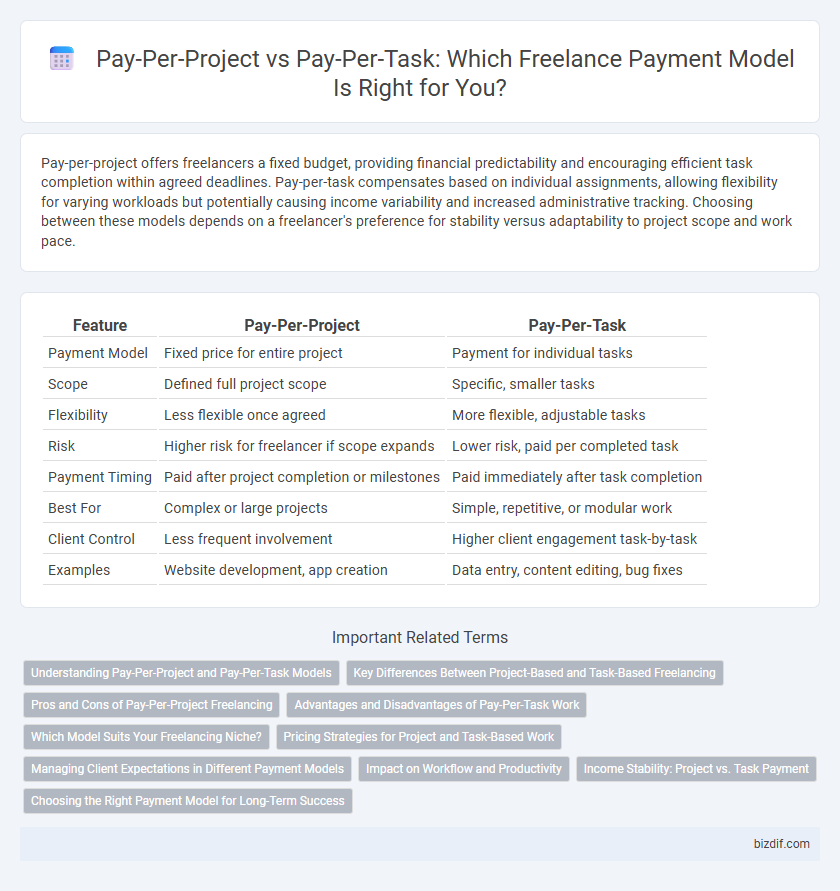Pay-per-project offers freelancers a fixed budget, providing financial predictability and encouraging efficient task completion within agreed deadlines. Pay-per-task compensates based on individual assignments, allowing flexibility for varying workloads but potentially causing income variability and increased administrative tracking. Choosing between these models depends on a freelancer's preference for stability versus adaptability to project scope and work pace.
Table of Comparison
| Feature | Pay-Per-Project | Pay-Per-Task |
|---|---|---|
| Payment Model | Fixed price for entire project | Payment for individual tasks |
| Scope | Defined full project scope | Specific, smaller tasks |
| Flexibility | Less flexible once agreed | More flexible, adjustable tasks |
| Risk | Higher risk for freelancer if scope expands | Lower risk, paid per completed task |
| Payment Timing | Paid after project completion or milestones | Paid immediately after task completion |
| Best For | Complex or large projects | Simple, repetitive, or modular work |
| Client Control | Less frequent involvement | Higher client engagement task-by-task |
| Examples | Website development, app creation | Data entry, content editing, bug fixes |
Understanding Pay-Per-Project and Pay-Per-Task Models
Pay-per-project models offer freelancers a fixed fee for completing an entire assignment, promoting clarity in scope and deadlines while encouraging efficient time management. Pay-per-task models divide work into smaller, discrete units with individual payments, allowing flexibility and incremental progress tracking. Choosing between these models depends on project complexity, freelancer preference, and client expectations for payment structure and deliverables.
Key Differences Between Project-Based and Task-Based Freelancing
Project-based freelancing involves a fixed fee for the entire project scope, ensuring predictable income and clear deliverables, while task-based freelancing pays per individual task completed, offering greater flexibility but variable earnings. Project-based contracts emphasize comprehensive planning, timelines, and client expectations, whereas task-based work allows freelancers to pick smaller, discrete assignments, often suitable for quick turnaround or ongoing micro-tasks. Understanding the key differences impacts workflow management, payment security, and client freelancer relationships in the gig economy.
Pros and Cons of Pay-Per-Project Freelancing
Pay-per-project freelancing offers clear budget expectations and allows freelancers to manage time flexibly, enhancing efficiency for well-defined outcomes. However, the fixed pricing model can lead to underpayment if project scope expands unexpectedly, and it may cause disputes over deliverable requirements. Clients benefit from predictable costs but risk receiving incomplete work if expectations are not explicitly communicated and documented.
Advantages and Disadvantages of Pay-Per-Task Work
Pay-per-task work offers freelancers the advantage of clear, manageable objectives with immediate payment upon completion, improving cash flow and motivation for short-term projects. However, it may result in inconsistent income and increased pressure to complete numerous tasks quickly, potentially reducing job quality and long-term client relationships. This payment model suits freelancers seeking flexibility but requires disciplined time management to balance productivity and earnings stability.
Which Model Suits Your Freelancing Niche?
Pay-per-project suits freelancers in creative fields like graphic design or web development, where deliverables are well-defined and client expectations are clear. Pay-per-task benefits niches such as content writing or virtual assistance, where work can be broken down into smaller, manageable units with measurable outcomes. Choosing the right model depends on project complexity, client workflow, and the freelancer's ability to estimate time and resources accurately.
Pricing Strategies for Project and Task-Based Work
Pricing strategies for freelancing vary significantly between pay-per-project and pay-per-task models, where pay-per-project involves a fixed fee covering the entire scope, promoting budget predictability and incentivizing efficient workflow. Pay-per-task pricing breaks down work into smaller, individual units, allowing flexibility and precise compensation for discrete deliverables, which can increase transparency and client satisfaction. Successful freelancers analyze project complexity, client requirements, and time investment to select optimal pricing strategies that maximize revenue while maintaining competitive value.
Managing Client Expectations in Different Payment Models
Managing client expectations in pay-per-project models requires clearly defining deliverables, timelines, and milestones to avoid scope creep and ensure mutual understanding of the project's overall value. In pay-per-task arrangements, transparent communication about each task's requirements and deadlines helps maintain clarity and prevents disputes over partial payments. Both models benefit from detailed contracts and regular progress updates, enhancing trust and satisfaction in the freelancing relationship.
Impact on Workflow and Productivity
Pay-per-project compensation encourages freelancers to focus on delivering comprehensive results within deadlines, fostering deeper engagement and efficient time management. Pay-per-task structures can lead to fragmented workflows, as constant switching between tasks may disrupt concentration and reduce overall productivity. Choosing the appropriate payment model directly impacts workflow continuity and the ability to maintain high-quality output throughout the project lifecycle.
Income Stability: Project vs. Task Payment
Pay-per-project offers freelancers consistent income through fixed fees upon project completion, enhancing financial predictability and budget planning. In contrast, pay-per-task can result in variable earnings due to fluctuating task availability and scope, challenging stable cash flow management. Choosing pay-per-project arrangements generally provides greater income stability compared to the more fragmented pay-per-task model.
Choosing the Right Payment Model for Long-Term Success
Choosing the right payment model in freelancing significantly impacts long-term success and client relationships. Pay-per-project offers clear scope and fixed budgets, ideal for well-defined deliverables, while pay-per-task provides flexibility and ongoing income for varied, smaller assignments. Freelancers should assess project complexity, client reliability, and cash flow needs to determine the most sustainable option.
pay-per-project vs pay-per-task Infographic

 bizdif.com
bizdif.com